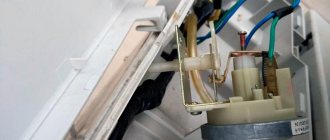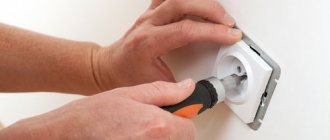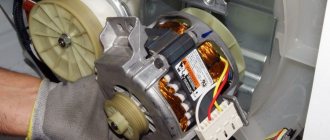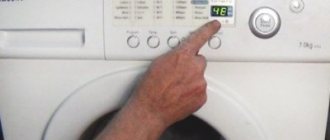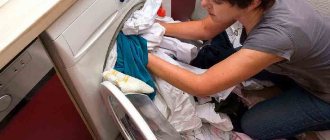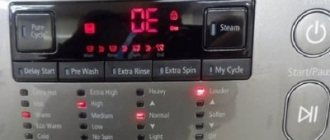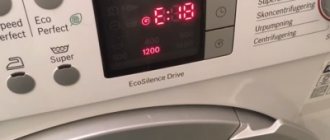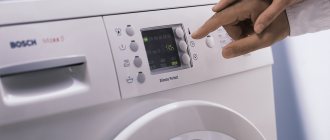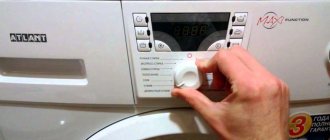The impeller of the SMA drain pump often fails. In such a situation, experts recommend completely replacing the pump. But a real Russian person, undoubtedly, would be sorry to throw away a functioning pump because of a faulty plastic part. You can try to replace the impeller, and if the process goes smoothly, the pump will return to normal operation and continue to pump out water without any problems. Let's figure out how to remove the impeller from the washing machine pump and how to restore the functionality of the drain element.
Impeller dismantling process
If you decide to remove the impeller from the pump with your own hands, we will help you with this. Let us present a detailed algorithm for dismantling a plastic part. So, after the drain pump is removed from the washer body, perform the following manipulations:
- cut off the plastic part located at the end of the impeller with a hacksaw;
- forcefully pull out the prefabricated base together with the impeller from the water pump;
- insert the removed structure into a vice and securely fix it in it;
- Take 2 flathead screwdrivers and, placing them on the bottom of the plastic screw, gently press upward on the impeller with upward movements.
At this stage, the main thing is not to overdo it and not to break the fastening of the drain pump impeller.
After lifting and pulling the impeller up, it should fly off the mount. When the plastic impeller is removed, you will see the shaft that powers it.
Now you need to remove the metal shaft from the overall structure. To do this, unscrew the vice from the tabletop, turn it over and reinstall it so that the compression bars are on the bottom. After this, the element to be disassembled is clamped in a vice in the area of the metal shaft.
Then you need to take a screwdriver, install its end into the upper hole of the shaft (it is important to choose a screwdriver of a size that matches the diameter of the hole) and carefully tap it from above with a hammer. The shaft should remain in the vice, and the structure remaining in the hands should be free to understand.
It is possible that the problem with the impeller was caused by abrasion of the rubber in the shaft area. Therefore, carefully inspect it and, if necessary, replace the rubber ring with a new one. The process of dismantling the impeller with your own hands is completed; you need to proceed to reassembling the element.
Prevention and Maintenance
Long service life and trouble-free operation are possible only if proper operating conditions and regular maintenance of the pump are observed. Maintenance means periodic inspection and cleaning of the pump. Inspection for abnormalities in operation should be carried out at least once a quarter, that is, twice during the heating season. It is advisable to perform cleaning every two to three years, depending on the quality of the water and the conditions in which the pump operates.
During the entire period of operation, it is advisable to periodically check the operation of the pump:
- Connections are checked for leaks. If identified, gaskets and seals (tow, FUM tape, etc.) are replaced.
- The presence and condition of grounding is visually checked.
- The sound of a running engine should not be accompanied by clangs, knocks, or extraneous sounds.
- The engine should not vibrate much.
- The pressure in the line is checked and its compliance with the nominal one.
- The housing must be clean and dry. If this is not the case, then you should carry out external cleaning, check the electronic unit for flooding and eliminate the reason why the pump is wet.
Approximately every two to three years, it is advisable to clean the pump, including all its elements. This only applies to models that can be disassembled. There are pumps with a pressed or solid, welded casing that does not require repair or disassembly. Such units fail and are then replaced with a new assembly. It is advisable to entrust this work to a service center. However, if you have the skills and tools, you can do everything yourself
- hex wrench;
- slotted screwdriver (flat) 4 and 8 mm;
- Phillips screwdriver.
Before disassembling the pump, drain the water from the system or drain a separate area in which the pump is involved, dismantle it and then begin disassembly.
- Using a hex wrench or Phillips screwdriver, unscrew 4-6 bolts around the perimeter of the engine housing at the junction with the shell of the pump part.
- Remove the shell, leaving the impeller on the rotor shaft along with the engine.
- Locate four drainage holes around the perimeter. Using a narrow slotted screwdriver, pry the jacket of the engine compartment under the impeller little by little around the perimeter. As a result, the shaft with the rotor and impeller will come out of the grooves and stator shell. You can help yourself by unscrewing the protective plug on the outside of the pump, inserting a screwdriver into the slot at the end of the shaft and lightly knocking the shaft out of the support bearing.
The analysis is now complete. Now you should clean the surface of the rotor, impeller and the inner surface of the shell from plaque and scale, if any, without damaging the surface of the parts. It is not permissible to use a coarse abrasive. It is better to use a brush with hard polymer bristles. Cleaning products containing a weak solution of hydrochloric acid can help. As a last resort, the finest sandpaper is used - “zero”.
For wet rotor pumps, it is important to check the cleanliness of the channel inside the shaft and the drainage holes located in the protective jacket separating the area of the pump part and the motor. The fluid enters the rotor precisely through these holes and then returns through the internal channel; if they are clogged, engine cooling suffers.
For pumps with a dry rotor, waterproofing the support bearing is important. If a leak is detected from the pump block to the stator block, then all gaskets and seals inside the device should be completely replaced.
READ MORE: The lower impeller in the dishwasher does not rotate
The condition of the bearings on which the shaft rests is checked. If they are already quite broken, they will need to be replaced, which is extremely difficult to do at home; you will have to contact a service center.
All seals and gaskets inside the pump should be checked for wear and replaced with new ones if necessary. Once all elements have been cleaned and checked, reassembly is carried out in reverse order.
Circulation pump needs cleaning
Restoring the impeller base
Half of the work is completed, now the logical question arises: how to restore the impeller base? If you managed to disassemble the structure correctly, then putting it back together will not be difficult. So, you need to do the following:
- insert the metal shaft into the plastic impeller; to ensure a tight connection, you can press it into the seat with a screwdriver;
- lubricate the rubber gaskets of the structure with lithol;
- attach the shaft with the impeller on it to the rubber part;
- clean the internal cavity of the pump (where the impeller base will be inserted);
- install the structure inside the pump (it will be attracted by a magnet).
- Apply sealant to the cavity in the area of the upper plastic part cut off from the impeller.
This way you can replace the pump impeller. The process happens quite quickly, it will take about one hour to complete the work. The main thing is to prepare all the tools necessary for repairs and imagine what the essence of the upcoming manipulations is.
What you can do yourself
- The water stop program has been selected. The machine stops without finishing work if the stop program without draining the water is selected. This mode is used for highly wrinkled fabrics. The wash itself is completed, but the water does not leave the tank to protect things from wrinkles. If you accidentally turn on this mode, change the program and run a regular wash with drain. For delicate items, you need to drain the tank without spinning.
- The drain filter is clogged. It is located in the drain path in front of the drain pump, traps debris and protects the pump from mechanical damage to the impeller. Without regular cleaning, debris accumulates and creates an obstruction to the water. The pump cannot pump out the water that reaches it drop by drop. Clean the filter regularly, at least several times a year. This way you will protect the pump and washing machine from unnecessary breakdowns, and save yourself from unnecessary repair costs. Instructions for cleaning the filter are in the manual for your SMA. It indicates where to find the filter assembly, how to clean it, and how often. If you have additional questions, you can ask our specialists.
- Blockage in siphon or sewer pipe . The drain hose of the washing machine is connected to the sink siphon or directly to the sewer pipe through an outlet. The siphon or pipe becomes clogged over time. A clogged siphon will be “signaled” by water retention in the sink; the blockage in the pipe will be less noticeable if only the washing machine “sits” on it. You can check that the reason is in the sewer, and not in the machine itself. To do this, before you start washing on an empty machine, you need to pull the hose out of the siphon or outlet, lower it into the container and turn on the quick wash and drain. If the water leaves without delay, then the problem is in the sewer system. Disassemble the siphon to clean it. To remove a blockage in the pipe, use special tools or use a plumbing cable.
Attention! If the machine stops while washing without draining the water, you need to drain everything manually before repairing. How to do this correctly, read further in the article.
Perhaps the pump is intact?
Do not immediately panic and disassemble the structure at the first doubt. First, figure out what kind of breakdown occurred, where it is located, and whether repair of the drain pump is necessary. It may not even be a faulty pump. The verification algorithm will be as follows:
- listen to how the drain pump works;
- examine the garbage filter, check it if necessary;
- inspect the drain hose; if there is a blockage, clean it;
- check whether the impeller rotates freely; perhaps its movement is being inhibited by something;
- examine the wires and sensors leading to the pump.
You can determine a malfunction by ear; you don’t have to be a master to do this. Listen to your washing machine, especially when draining the water from the tank. If the washer operates without making any extraneous noise, you will have to disassemble the body a little to be able to check the drain hose, filter, and wiring.
Interesting:
- Share your opinion - leave a comment
The washing machine may malfunction due to the operation of the internal pump. Water will flow out of the hose slowly or in jerks when the laundry is spinning. The pump or pump is one of the most important components in the operation of a washing machine. It is important to identify the fault in time and make repairs. This article talks about repairing the internal pump and how to prevent the problem.
How to change the pump yourself
One of the most difficult failures, in which the washing machine has stopped spinning and draining water, and is also humming, is a pump malfunction. In this case, it will most likely need to be replaced.
Washing machine pump
Let's look at the procedure for replacing the pump:
- The drain assembly must be removed.
- The drain pump is detached from the drain assembly.
- The wires that go to it are removed from the pump.
- A new unit is installed in place of the old pump.
- Wires are connected to the new pump.
- The drainage unit is installed in its place.
- The machine is connected to the network and a test wash is performed.
- If the washing machine continues to drain water poorly, contact customer service.
About details
A pump is an internal pump in a washing machine that pumps waste water out of the tank. It works during the initial spinning of the laundry or when rinsing it. Pumping out water without a pump is impossible.
There are two types of pumps - drain and recirculation. The first one works only for draining. The second can operate in drain mode or be connected at the stage of rinsing clothes, passing water in a circle.
Usually the pump is an intermediate link between the drain channel and the snail in which the filter is located. It is located at the bottom of the machine. This simplifies its diagnosis and maintenance. The pump itself consists of a plastic casing, a motor and an external impeller, which pumps dirty water out of the washing machine.
Checking the pump volute
If you hear an unusual noise in the area where the pump is located (the lower right side of the machine), then perhaps a small object has gotten into the pump volute after washing or a critical blockage has occurred. If this happens during the washing process, you will first have to empty the water from the drum. The check is as follows:
- Open the cover in the lower right part of the panel.
- We see a round hole with a plug - this is a filter.
- We open the filter by unscrewing it. Water leakage is possible, so we will place a small flat container in advance.
- We look inside the cochlea cavity (you can illuminate it with a flashlight), remove foreign objects if they are there. In normal condition, we will not see anything other than the pump impeller. Except in cases where two motors are installed on one snail - one for draining, the other for recirculation (watering).
Another traditional reason is a clogged inlet pipe. Purely mechanical cleaning will help.
Required Tools
Repairing the pump is simple, as it does not require many tools or special devices. Most often, three things are enough for dismantling and repair:
- Phillips screwdriver;
- sharp knife or chisel;
- electric voltmeter.
Pliers or pliers are useful as auxiliary tools to remove the clamps from the hoses.
Prepare a dry rag and bucket in advance . There will likely be a small amount of water in the pump that will spill onto the floor.
How to repair a pump in LG or Samsung models?
As an example, we will consider LG and Samsung washing machines with a load of up to six kilograms. These models can be found often, as they are very popular. They usually have a similar design:
- Open bottom without plastic or other protection. This arrangement makes it easier to maintain and repair the washing machine.
- Technical hatch in the lower right part. This door is made for replacing and servicing the coarse wastewater filter.
- A plastic cover on the front bottom of the washer that hides the fixing bolts.
There are more complex models for 8 or more kilograms . Such washing machines have special protection at the bottom, additional shock absorbers and water overflow sensors. These models are too complex for DIY home repairs and are not widespread, so their maintenance will not be considered in the article.
Disassembly
Disassembly should begin by turning off the device from the electrical network. It is worth checking that the tank is full. Sometimes pumps in washing machines break when the wash is in full swing and the device is filled with water. This point is worth considering so as not to collect soapy liquid all over the floor in the bathtub.
If the tank is completely filled with water, then you need to drain it into a basin. To perform this operation, you need:
- Raise the back of the machine above the floor at the height of your pelvis. You can add old books or boards.
- Then tilt the machine slightly onto its back so that its back rests against the wall and locks in this position.
- Carefully crawl up from the bottom and disconnect the inlet tube from the tank to the cochlea. In this case, you need to plug the hole in the hose with your finger so that water does not spill onto the floor.
- Place a basin under the machine and release the hose hole.
It is best to have two people drain the water, so that one person is always on hand. Moreover, a washing machine with a full tank of water will be very heavy. It is not easy to cope with such a task in one hand.
Another important point is primary diagnosis. Perhaps your machine does not require major repairs. To find out, you need to do an initial examination before preparing for the main work.
By doing repairs yourself, you automatically remove the warranty from your household appliance ! Remember this. If you are not confident in your abilities, take the machine to an official service center.
You can view instructions for disassembling washing machines of different brands here.
How to determine a breakdown?
If the water stops draining, and the machine works and turns on, you need to do a number of manipulations:
- Check the drain hose for bends and kinks. Perhaps in one of the places it has a bend - water simply cannot pass through this area.
- Listen to the machine work. If you hear a loud crunching or crackling sound in the bottom area during push-up mode, you should check the coarse filter. Perhaps it is simply very clogged and water cannot pass through in this place.
- Remove the filter and check the condition of the pump impeller. If it is in its place, try to scroll it. There are times when it simply gets stuck in one position.
- Check the contact on the pump. To do this, you will need to carefully lay the machine on its side and inspect the contact of the power wire to the pump. If necessary, you can remove the terminal from the socket and put it back in place. Then try to start the machine.
Washing machine pump repair
From life
A breakdown of a washing machine is like “out of the blue.” Everything happens suddenly and rapidly. You arrive home late at night after work. Tired, no strength. Things don’t work out at work with your boss, and with your colleagues too.
Not good. You turn on the TV. A plate under your nose. You try to look at the screen with one eye and... instantly your face ends up in food. You are sleeping and seeing your tenth dream. You wake up and then it starts...
You remember that you forgot to wash your shirt. You scold yourself for being a “bad person.” You quickly put the shirt into the drum of the washing machine, pour in the powder with trembling hands, and leave it for 30 minutes. Bang! The car “stalled” - in the language of avid motorists. Panic, horror, thoughts of a reprimand at work! What to do? How to be?
Real-time repair
The Stirrem.ru company will never leave its clients in trouble, even in the most critical situation. We will promptly help you fix any damage.
Within a short period of time after your call, the technician will arrive on site. Our company’s specialists will perform preliminary diagnostics of the device and carry out repairs.
Below, you can learn more about the function of the pump and find out what it is.
What is a pump?
water pump
in a washing machine this is a very important element. It is a miniature pump, which is located at the very bottom of the device. While the machine is running, all used water goes down the drain. It is the pump that allows you to speed up this process and drain excess water faster. There are two types of pumps:
Nowadays, as a rule, they are no longer installed with an impeller. But they can still be found on older Ariston and Indesit models.
If it so happens that there is water left in the drum during washing, the reason most likely lies in the pump. How to repair a pump
read below...
"Attention! We do not recommend doing self-repairs. It’s better to entrust this matter to professionals.” DIY repair
DIY repair
“Remember ! All of the following is relevant only for a pump with an impeller mechanism.”
What do you need? To be honest, apart from a regular knife and a Phillips screwdriver, nothing. So let's get started right away.
2) Next you will need to remove the back wall of the washing machine. As a rule, all fastenings are held on with ordinary self-tapping screws. After which, having carefully examined the device, we find the pump itself in the lower corner. We disconnect the wires coming from it, unscrew the pump, remove the hoses.
3) After which, you need to disassemble the pump itself. To do this: unscrew the pump volute from the pump body itself. We write down the order in which the engine was installed. Then we carefully remove the engine with the impeller from the snail itself. Let's check if everything is in order. We manually turn the impeller blades; as a rule, they should spin easily (intermittent movements are allowed.)
4) Basically, the breakdown occurs due to the fact that during the use of the washing machine, under the influence of hot water, the casing becomes deformed. Therefore, the impeller blades freely touch it and a breakdown occurs.
"Warning! Don't cut too much. If you remove excess, the pump’s performance will decrease.”
6) Then we put everything back together in reverse order and start the car.
If you succeeded, congratulations. If not, then there is only one option - buying a new pump.
. You can install and purchase a pump from our company at an affordable price. See below for more details...
About us again
Rest assured, using the services of our service center, you can forget about your problems. We work from 9.00 to 21.00, and around the clock. Who said Saturday and Sunday are days off? Taking care of our clients is more important than relaxation. We will create a schedule for the specialist’s arrival individually for you and select the desired day.
We guarantee you quality and reliability. All parts for repairs are purchased from our German partners. Therefore, the part installed in your washing machine can last for many more years.
The company has a transparent pricing policy. And for our regular customers there are various discounts and promotions. Read more
Hurry! Place your order right now and get a discount on 3 services!
Expert advice
Professional technicians who service machines know several causes of breakdowns that do not lie on the surface, but affect the performance of the pump:
- Particularly “bouncy” machines can fray the power supply wires of the pump during washing. Then the pump will appear to be in good working order, but will not work and spin. To diagnose this problem, you will need to disassemble the device down to the electronic control unit. This repair is quite labor intensive. Only a master can handle it; a beginner cannot repair it.
- In some cases, the electronic control unit program may fail. Such diagnostics and repairs can only be performed by a professional technician with special equipment.
- Another rare malfunction is a blockage in the hose running from the main tank to the volute with the pump. It can be determined by hand, squeezing different areas in turn. If necessary, the hose can be removed and cleaned under strong pressure from the tap.
Most often, technicians check the contact group and the pump impeller. If the cause of the breakdown does not concern these parts, the specialist simply replaces the entire assembly.
You can repair the washing machine pump yourself. This is a simple operation, especially if you have an assistant. When working, you need to take precautions, do not forget about the remaining water in the tank and do not try to repair or solder the pump unless the impeller or contact group is involved.
Useful tips
Do not rush to disassemble the washing machine and change the drain pump - first determine exactly what the cause of the breakdown is. To do this you will have to follow simple steps:
- “listen” to the pump;
- open the drain filter and clean it;
- clean the drain hose;
- determine how the pump impeller rotates;
- check the contact group and all sensors going to the pump.
A number of malfunctions can be easily determined by ear - just walk up to a running washing machine and listen. You should wait until the liquid is drained or withdrawn. When the pump starts to hum and tries to work intensively, but there is no water in the tank, or no sounds are heard from the pump, you have localized the breakdown.
[custom_ads_shortcode1]
Causes of pump failure
- The pump broke down due to a malfunction of the engine, as a result of which there is no voltage to the pump.
- The seal (rubber or plastic) is damaged by scale and dirt that settles on the impeller.
- Incorrect connection of the pump or failure of the water level sensor causes the pump to constantly operate.
- The pump will not be able to drain water due to a clogged filter.
- Small foreign objects destroy the impeller. It's easy to diagnose. When the pump starts, the machine makes a hooting sound.
Where is the pump located
Models of washing machines Candy, LG, Whirpool, Ariston, Beko, Samsung are equipped with a pump located at the bottom. To get to it, the washing machine is laid on its side and the bottom panel is removed. The snail with the filter is attached with screws that can be unscrewed and the required part is in your hands.
If we talk about Zanussi and Electrolux models, their pump is located behind the back cover, which will need to be removed.
The most difficult models to disassemble are Bosch, AEG, Siemens. They will have to dismantle the entire front panel.
DIY washing machine pump repair
Under heavy loads, the pump is protected by fuses that are located on the winding of the part and are switched off. When the temperature normalizes, the contacts are restored.
First you need to disconnect the pump from the cochlea . In general, there are two types of fastening: simply with screws and without screws (you only need to turn the pump counterclockwise). At this stage, you can find out whether the impeller rotates on the shaft. Normally, it should spin with small delays, so-called jumps. This is due to the action of a magnet rotating in a coil. If it is difficult to turn and there is no debris, then you will have to completely disassemble the part and see if it is possible to repair the washing machine pump impeller.
The motor housing has a latch on both sides that needs to be unhooked with a screwdriver. This is if your car has a collapsible motor, but there are non-separable types. At first glance it is impossible to make out, but if you know some of the nuances, you can.
A construction hair dryer will help by heating the long part of the part, the so-called shank at a low temperature. After heating the shank, the crosspiece with the magnet is removed from the housing. Usually dirt accumulates on the magnet and in the place where it was pulled out. After cleaning, the magnet itself is removed. Next you will see the bearing, which is also cleaned and lubricated. After these procedures, the part is reassembled. There is a ring under the blades that should fit tightly into place. The seal may need to be replaced.
Bearing wear
Because of this, friction appears between the volute and the impeller, which causes problems and repairs of washing equipment pumps. The problem can be solved by replacing the bearings. In an emergency, when it is not possible to buy a new part, and washing cannot wait, only shortening the blade by no more than 2 mm will save you. This is done with a sharp knife.
After repair, the housing is installed in the coil and fixed. This concludes troubleshooting the pump on your own.
Useful video
A couple of removal methods:
Do-it-yourself circulation pump repair - step-by-step instructions
DIY circulation pump repair
Circulation pumping devices are very popular among owners of private houses and summer residents. The range of pumping equipment is quite wide, but the general principles of the device are the same. Such equipment can stop due to minor breakdowns, for example: the pressure switch of the pumping station does not work, what should I do?
READ MORE: Do-it-yourself refrigerator door repair: adjustment, elimination of squeaking and sagging - TechnoExpert
How to prevent pump failure
If you follow these recommendations, you can significantly extend the life of the drain pump.
- Always remove foreign objects from pockets before washing.
- Use bags for washing clothes.
- In case of strong, coarse dirt, clean things, and also remove animal hair by hand before entering the machine.
- Install filters at the inlet of the filler pipe.
- Carry out scale prevention.
- When washing items with buckles or rivets, turn the items inside out.


